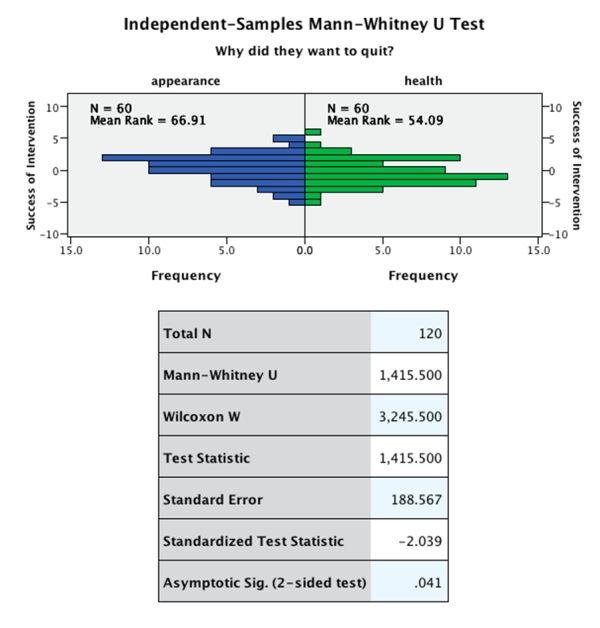Multiple Choice
Imagine we wanted to investigate whether the reason for quitting smoking affects success rate.We recruited a sample of 120 smokers.Half wanted to quit to improve their appearance (yellow teeth and bad breath,etc.) ,and half wanted to quit to improve their health (life expectancy,etc.) .After six months we measured how successful they had been at quitting smoking.The data were skewed,so we ran a Mann-Whitney test on the data (output below) . Which of the following sentences correctly reports the results from the Mann-Whitney test? 
A) People who wanted to quit smoking to improve their appearance did not significantly differ from those who wanted to quit to improve their health,U = 1415.50,z = −2.04,p = .04.
B) People who wanted to quit smoking to improve their appearance (M = 66.91) were significantly more successful at quitting than those who wanted to quit to improve their health (M = 54.09) ,U = −2.04,z = 188.57,p = .04.
C) People who wanted to quit smoking to improve their appearance were significantly more successful at quitting than those who wanted to quit to improve their health,U = 1415.50,z = −2.04,p = .04.
D) People who wanted to quit smoking to improve their health were significantly more successful at quitting than those who wanted to quit to improve their appearance,U = 1415.50,z = −2.04,p = .04.
Correct Answer:

Verified
Correct Answer:
Verified
Q1: The _ and _ tests are calculated
Q6: Which of the following tests would you
Q8: When the groups have equal numbers of
Q11: You have carried out a Kruskal-Wallis test.
Q13: A psychologist was interested in whether there
Q15: What can be done to reduce the
Q16: A researcher measured people's physiological reactions while
Q17: Imagine we wanted to investigate whether the
Q17: When the groups have unequal numbers of
Q20: The _ test is based on calculating